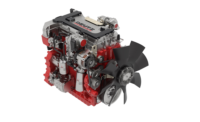ENR Award of Excellence winner Jeffrey Baker’s pet project—the ultra-green, ultra-affordable Research Support Facility (RSF) at the Dept. of Energy’s National Renewable Energy Laboratory (NREL) in Golden, Colo.—is but a tiny example of the work funded through DOE’s Office of Renewable Energy and Energy Efficiency.

EERE’s overarching mission is to push the needle forward on energy efficiency and renewable energies, through research and development of solar energy, wind, biomass, water, hydrogen and fuel cell technologies, and, also, building technologies.
Since the American Recovery and Reinvestment Act of 2009, EERE has had an annual budget of more than $2 billion.
EERE claims that its programs could save consumers over $800 billion by 2030 and as much as $6 trillion by 2050. EERE also claims its programs could also reduce annual costs to the electric power sector by $500 billion by 2030 and $1.3 trillion by 2050. Similarly, EERE’s technologies could avoid 10 gigatons of carbon by 2030 and more than 45 gigatons by 2050. And its investment portfolio is expected to offset 4 billion barrels of imported oil by 2030 and nearly 40 billion barrels by 2050.
A tiny example of work in the buildings sector is the RSF, which not only houses NREL staff but is itself a living laboratory for NREL to study performance of large-scale energy-efficient commercial buildings.
And though the RSF is just one building, it is one of the most energy-efficient in the world. And it has the potential to transform the nation’s building energy-use landscape. That’s because the RSF team developed a new model that relies of performance-based design-build, for the delivery of affordable, extremely energy-efficient commercial buildings.
Baker, who oversees the lab for DOE as director of laboratory operations in the Golden Field Office of EERE, spent 12 years trying to get funding for the RSF, which started out as a pet project, outside of his regular duties, and, along the way, morphed into a potential game changer.
“The goal of Jeff Baker, through the RSF, was to show [the nation] the opportunity for new construction that is 50% more efficient than the code and for retrofits that are 30% more efficient,” says Roland J. Risser, manager of EERE’s building technologies program. “This is the government showing what is possible to the private sector. President Obama has asked the government to be a model and this is a perfect example.”
Within the building technologies program, EERE has two vehicles in place to help spread the word about the RSF to the private sector: the commercial building energy alliances program and the commercial building initiative program. “Both groups can learn from the RSF,” says Risser.
Commercial Building Energy Alliances bring together industry representatives to find solutions that minimize the energy use and environmental impact of commercial buildings. The alliances focus on retailers, hospitals and commercial real estate. The Commercial Building Initiative works with commercial builders and owners to reduce energy use and optimize building performance, comfort, and savings, by sharing lessons learned.
One big lesson members of the groups can glean from the RSF model is that the owner must define a building’s energy use goals up front and then stay the course during design and construction. “The owner needs to say, “this is what I want for an energy goal and the owner needs to be willing to say, ‘I will not compromise,” says Paul Torcellini, NREL’s group manager for commercial buildings. For the RSF, “Jeff’s team and NREL—which represented the owner—were unwavering,” he adds.
Baker is still unwavering, and his commitment to energy conservation goes way beyond the RSF. He takes advantage of every opportunity to enlighten the nation about the problem.
“The national energy appetite is tremendous,” he says. “Currently we consume about 95 quadrillion BTUs of energy annually, about 20% of the world’s total consumption.”
Only 8% of the nation’s energy comes from renewable sources, primarily biomass, says Baker. This is changing, he adds, but it will take decades to undo a system that took more than a century to develop. “Our national security, economic and environmental interest can’t wait that long,” he says.
But he does more than enlighten, he inspires.
And for those who develop, design and construct buildings, he offers the follow advice: Begin with the end in mind—in this case, energy efficiency; unleash the creativity of the team; use performance-based design-build delivery; and invest in and trust people.



Post a comment to this article
Report Abusive Comment